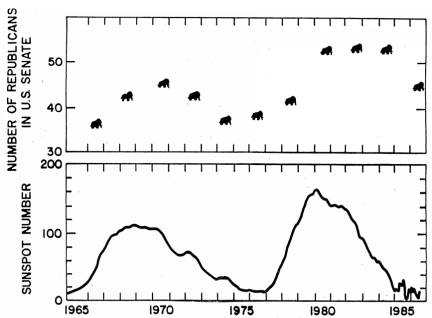
| MadSci Network: Astronomy |
Sorry for the delay: my browser crashed while I was proofreading the first version of this answer.
If I understand your reasoning, you're saying that since solar flares affect the electrical power grid, and lighning is a flow of electricity, then maybe solar flares affect lightning. A good idea. To test it, we need to know how solar flares affect the power grid.
The sun undergoes an 11-year cycle of activity. During the "active" period, the sun has many flares, sunspots, and other features. During the "quiet" period, it does not. During the active period, the sun is about 0.1% brighter than usual, and flings off streamers of ionized gas. These streamers ("coronal mass ejections") are flung away from the Sun; some of them strike the Earth's magnetic field, causing changes in the field (a "geomagnetic storm"). These changes are about 1% of the total strength of Earth's magnetic field, and take place over a few minutes. The changes in the Earth's field affect the electricity flowing through power lines that cover the continents: voltages are induced which can damage electrical equipment, causing blackouts.
The voltage induced in a conductor (like a copper wire or lightning bolt) by changes in a magnetic field depends a great deal on the length of the conductor, or the area enclosed by a loop of it. I made a very rough calculation which says that the voltages created in the North American power grid during a typical geomagnetic storm might be 50,000 volts. (The uncertainty here is a factor of 10 or more). This is a substantial fraction of the 400,000 volts at which the nationwide power grid usually operates.
A lightning bolt is much smaller, so the voltages created will be much smaller. It's difficult to estimate how much smaller, because a lightning bolt is a very different sort of conductor than a loop of wire, but I estimate that a geomagnetic storm could cause changes of 100 volts at most across the bolt, possibly hundreds of times smaller. This is a tiny fraction of the many millions of volts normally bridged by a lightning bolt, so I expect that solar flares will have little effect on lightning.
Another way to look at your question is to note that the sun is brighter by 0.1%, realize that this causes the atmosphere to heat up, and ask whether this could generate more thunderstorms. I think this is unlikely. The change in brightness is tiny, so we would expect only a very small effect. In addition, the 0.1% more energy received by the earth is tiny compared to other changes in the Earth's heat budget, such as the Greenhouse Effect and changes in land surface due to human activity. The majority of climate scientists agree that changes in sun brightness don't have much effect
However, some people disagree with me. Two web sites with dissenting opinions are Solar activity: A dominant factor in climate dynamics, and The Unity of the Sun, Earth, and Moon. The second site is essentially useless pseudoscientific babble, as far as I can tell -- it does not cite its sources, and confuses basic scientific concepts (such as units of measurement). The first is better written, but cites papers which suffer from several basic errors in data analysis. (Details upon request.)
The effect of solar activity on Earth's climate has a long and dubious history in climate dynamics. During the 1800's, there was a "sunspot mania", in which incorrect statistical techniques were used in hundreds of papers to conclude that the solar activity cycle influenced everything from rainfall in the U.S. to crop yields in France. Most of these papers were found to be flawed, and most scientists are now extremely skeptical about claims like those made in the papers cited above.
As an example of how how easy it is to come to incorrect conclusions when looking for solar influences on earthly phenomena, check out the figure below. It shows an almost perfect match between the number of sunspots and the number of Republicans in the U.S. Senate, over a 20-year period. Does that mean that sunspots are influencing politics? Or vice versa? Since the peaks and valleys of sunspot number lie a few years ahead of the peaks of Republicans, can we use sunspots to predict elections? Of course not!

If you'd like more information about some of the stuff I've skimmed over, like the induced voltage calculations, or the statistical errors in the "Solar activity effect on climate" paper, or anything else, e-mail me.
Sources:
Kivelson and Russell: "Introduction to Space Physics". High-level
information about solar flares and geomagnetic storms.
Information about sunspot
cycles
Geomagnetic Storms, a good
description of how geomagnetic storms influence electrical power
systems.
Another good site on
geomagnetic storms and power systems
A
Mad Scientist writes about lightning and how it works
More information about
lightning
Try the links in the MadSci Library for more information on Astronomy.